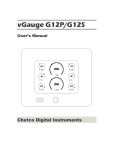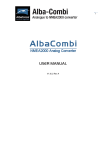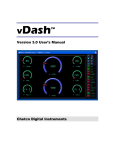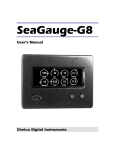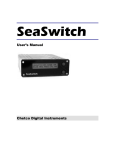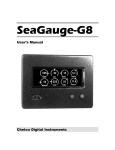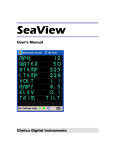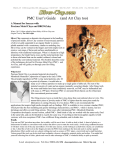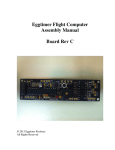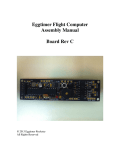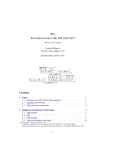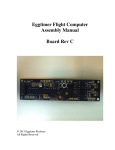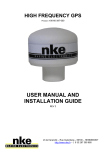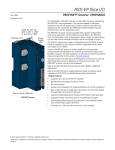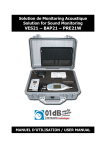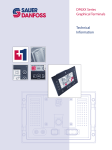Download SeaGauge-Remote Manual
Transcript
vGauge Remote User’s Manual Chetco Digital Instruments Copyright © 2010 Chetco Digital Instruments, Inc. All rights reserved. vGauge-Remote™ is a trademark of Chetco Digital Instruments, Inc. vDash™ is a trademark of Chetco Digital Instruments, Inc. WARNING! USE THIS UNIT ONLY AS AN AID TO MONITORING ENGINE PERFORMANCE INFORMATION. CAUTION When showing sensor data, this unit will only show information based on the sender used and its installed position. The operating and storage temperature for your unit is from -4 degrees to+167 degrees Fahrenheit (-20 to +75 degrees Celsius). Extended storage temperatures higher or lower than specified will cause the liquid crystal display to fail. Neither this type of failure nor its consequences are covered by the warranty. For more information, consult the factory customer service department. All features and specifications subject to change without notice. Chetco Digital Instruments may find it necessary to change or end our policies, regulations, and special offers at any time. We reserve the right to do so without notice. All screens in this manual are simulated. NOTICE! Free software upgrades will be available on our website at http:// www.chetcodigital.com as they are released. Please check our website periodically for these and other information as they become available. Thank you for choosing Chetco Digital Instruments This device complies with Part 15 of the FCC Rules. Operation is subject to the following two conditions: (1) this device may not cause harmful interference, and (2) this device must accept any interference received, including interference that may cause undesired operation. Note: This equipment has been tested and found to comply with the limits for a Class B digital device, pursuant to Part 15 of the FCC Rules. These limits are designed to provide reasonable protection against harmful interference in a residential installation. This equipment generates, uses and can radiate radio frequency energy and, if not installed and used in accordance with the instructions, may cause harmful interference to radio communications. However, there is no guarantee that interference will not occur in a particular installation. If this equipment does cause harmful interference to radio or television reception, which can be determined by turning the equipment off and on, the user is encouraged to try to correct the interference by one or more of the following measures: • Reorient or relocate the receiving antenna. • Increase the separation between the equipment and receiver. • Connect the equipment into an outlet on a circuit different from that to which the receiver is connected. • Consult the factory customer service department for help. SPECIFICATIONS Dimensions: .............................................6.76” W x 4.68” D x 2.3” H Input Voltage:..........................................10 - 15 vDC, 12-volt Nominal (24V option) Processor Frequency:.............................. 18.432 MHz Maximum Current:..................................800 mA Operating and Storage Temperature ... -4 to +167 degrees Fahrenheit 20 to +75 degrees Celsius - Analog Conversion Accuracy :..............10 bits Sender voltage range:.............................. 0 - 2.5 volts Sender voltage resolution:...................... 0.0128 volts Pulse Count resolution: .......................... 1 per second Maximum Pulse Count:.......................... 250 per second Analog Channels: .................................... 12 Pulse Channels:........................................ 3 Indicator Status/Switch: ........................ 12 Common Alarm Out: ............................. active High 2.5V, active Low 100 mA current Sink RS232 Serial Ports:.................................. 2 USB Slave Port: ....................................... 1 NMEA 2.0 Instrumentation Sentences $IIXDR,A $IIXDR,C $IIXDR,D $IIXDR,F $IIXDR,G $IIXDR,I $IIXDR,P $IIXDR,R $IIXDR,S $IIXDR,T $IIXDR,U $IIXDR,V NMEA 2000 PGNs PGN 127488, PGN 127489, PGN 127501, PGN 127502, PGN 127505, PGN 127508, PGN 127493, PGN 130312, PGN 130311, PGN 130323, PGN 130306, PGN 127250, PGN 127257, PGN 127251 Chetco Digital Remote Display support protocol – G18S, G12C, G24C, G32C Table of Contents Table of Contents ................................................................................................................................5 Introduction..........................................................................................................................................8 Welcome ...........................................................................................................................................8 .......................................................................................................................................................9 Analog Inputs –...........................................................................................................................9 Optional EGT inputs –..............................................................................................................9 Pulse Inputs -.............................................................................................................................10 Alarm Output ............................................................................................................................10 vSwitch Port – ...........................................................................................................................10 Serial Interface –........................................................................................................................10 Slave USB interface – ...............................................................................................................10 Master USB interface – ............................................................................................................10 What You Get ....................................................................................................................................11 Unit..................................................................................................................................................11 Cables ..............................................................................................................................................11 Operation ............................................................................................................................................12 Sensor Inputs .................................................................................................................................12 Data Output format ......................................................................................................................13 Display Label Table.......................................................................................................................14 Channels Table ..............................................................................................................................15 Alarms Tables ................................................................................................................................16 Calibration Tables..........................................................................................................................18 OPTIONS Table...........................................................................................................................20 Connectors..........................................................................................................................................22 ..........................................................................................................................................................22 System Power.................................................................................................................................23 Sensors ............................................................................................................................................24 Sensor Dip Switches .....................................................................................................................26 Ports ................................................................................................................................................29 LED INDICATORS....................................................................................................................34 Board Jumpers ...............................................................................................................................35 PORT SWITCHES.......................................................................................................................39 FIRMWARE UPDATE SWITCH ........................................................................................42 Installation...........................................................................................................................................43 Mount..............................................................................................................................................43 Power ..............................................................................................................................................43 Alarm...............................................................................................................................................44 Pulse input ......................................................................................................................................44 Reference Voltage .........................................................................................................................44 Signals..............................................................................................................................................44 Calibration Tables ..............................................................................................................................46 Serial Port Protocols..........................................................................................................................48 NEXT MENU...............................................................................................................................49 SET Function.................................................................................................................................49 Real-time data.................................................................................................................................49 Program Mode ...............................................................................................................................49 Color Display Protocol.................................................................................................................51 NMEA 2000 PGNs ......................................................................................................................52 PGN 127488 Engine Parameters Rapid................................................................................53 PGN 127489 Engine Parameters Dynamic ..........................................................................53 PGN 127508 Battery Status ....................................................................................................53 PGN 127505 Fluid Level.........................................................................................................54 PGN 127493 Transmission Parameters ................................................................................54 PGN 130312 Temperature ......................................................................................................54 PGN 127501 Binary Switch Status.........................................................................................55 PGN 127502 Switch Command Control ..............................................................................55 One Year Warranty............................................................................................................................56 vGauge-Remote User’s Manual 7 vGauge-Remote User’s Manual Introduction Welcome Thank you for purchasing a Chetco Digital Instruments product. vGauge-Remote™ provides custom instrumentation in a rugged compact design. Its user defined calibration tables and alarms allow it adapt to and monitor many different sensors from a single location. vGauge-Remote™ will interface directly with a personal computer via serial or USB interfaces. Optional display heads provide real-time display of instrumentation in remote locations. 8 vGauge-Remote User’s Manual Analog Inputs – vGauge-Remote will support up to 12 analog inputs for interface to most temperature, pressure, and voltage senders. Internal signal conditioning allows resistive senders and direct voltage inputs up to 36 volts on selected inputs. Most temperature and pressure senders use variable resistance to convert physical parameters into an analog voltage. vGauge-Remote provides a 2.5 volts reference and proper pull-up resistance to interface with these senders. To accommodate more accurate measurements, vGauge-Remote also supplies +5 volt output to drive specified senders with require a regulated voltage source commonly found in high precision pressure senders. Optional EGT inputs – vGauge-Remote provides an option for built-in interface for up to two K-Type thermocouples commonly used for exhaust gas temperature (EGT) measurements. These probes output a very low level voltage (typically 0 – 0.5v) that need to be amplified and conditioned to obtain reliable results. vGauge-Remote EGT opyion provides the proper conditioning and calibration to attach K-Type EGT probes directly to the unit. When not configured for EGT input, A10 and A11 are set for conventional analog sensors 9 vGauge-Remote User’s Manual Pulse Inputs - vGauge-Remote can accept up to three pulse inputs from a variety of sources for measurement of revolution information such as tachometer and speedometer functions. vGauge-Remote conditions pulse inputs to allow direct interface to most tachometer signal generators. vGauge-Remote also provides pulse dividers up 256 ratio for interface to inductive pickup systems. Alarm Output – vGauge-Remote can be configured to support high/low alarm conditions on each of the 12 analog inputs and 3 pulse inputs. User specified alarm settings are combined into a single output used to drive visual or audio indicators such as a buzzer or panel lamp. vSwitch Port – 14-pin digital connector for attaching a vSwitch 12-channel Relay module or 12 input indicator module. Switch activation commands are passed through from either Port to control state of relays or provide ON/OFF status from indicators. Indicator status must use voltage dividers to convert analog voltage from 12V down to 2.5V. Do not connect directly to vSwitch port or immediate damage will result.. Serial Interface – dual built-in RS232 serial ports are provided for driving optional remote displays, NMEA 2000 adapter, or PC serial port. A Bluetooth and WiFi module is also available for wireless interface to PC and PDA devices. Slave USB interface – vGauge-Remote contains a slave USB 2.0 interfaces for connection to PC/Laptop. The USB interface is shared with the serial port and only is active on a select port at a time. Miniature switches are used to select RS232 Serial or USB mode for each port. Master USB interface – vGauge-Remote has an option to support two additional USB 2.0 interfaces for driving remote displays or data logging to flash memory disks. USB port 0 is for direct PC interface. Optional USB port 1 is used for attachment of compatible display head for real-time display of instrumentation data. USB port 2 is used for attachment of USB flash memory device for real-time data logging. NOTE: Only vGauge PRO supports data logging to USB Memory and USB Master modes. 10 vGauge-Remote User’s Manual What You Get Unit vGauge-Remote unit with power and sensor input. Unit constantly monitors the sensor inputs and creates NMEA 0183 compatible sentences two times per second. A 10-bit analog converter samples sensor data and then performs a real-time average. The built-in microprocessor takes the averaged value for each sensor and looks up the display value from a 256 point table that is user modifiable. Once a sensor value is determined, it is paired with a corresponding text label and sent via built-in serial port in NMEA 0183 format or optional NMEA 2000 adapter. Sensor data is also compared with a user defined min/max alarm table and will trigger an alarm signal if any of the parameters are exceeded. Cables vGauge-Remote is supplied with terminal blocks for attaching sensor and power inputs to the unit. Supplied USB and RS232 cables are used for attachment to remote PC or display heads.. 11 vGauge-Remote User’s Manual Operation vGauge-Remote is sealed and self-contained. All user control is performed via the built-in USB or RS232 ports. The unit can be configured with the included vDash utility described in a separate manual or via text commands sent directly to the serial port. When you receive your unit it has been programmed with default sensor calibration tables and labels. All alarms have been cleared. The unit can be reconfigured by modification of the tables using a text editor and reloading the unit. To prevent any errors in programming – it is recommended to use the included vDash utility for reprogramming of the unit. While it is possible to manually reconfigure the tables using standard serial communications utilities – any errors could render the unit inoperable and require reprogramming of the entire unit using the separate flash programming port. Sensor Inputs The factory default inputs include 4 temperature, 4 pressure, 2 voltage, 2 Fuel, and 3 pulse inputs. The following table describes the default sensor ranges and display labels Pin Channel Function Min Value Max Value Min Alarm Max Alarm A0 A1 A2 A3 A4 A5 A6 A7 A8 A9 A10 A11 P0 P1 P2 A0 TEMP1 -19 F 336 F OFF OFF A4 A6 A2 TEMP2 TEMP3 TEMP4 -19 F -19 F -19 F 336 F 336 F 336 F OFF OFF OFF OFF OFF OFF A10 VOLT1 0 28V OFF OFF A1 A5 A7 PSI1 PSI2 PSI3 0 0 0 150 150 150 OFF OFF OFF OFF OFF OFF A3 A11 A8 A9 P0 P1 P2 PSI4 VOLT2 Fuel1 Fuel2 PULSE0 PULSE1 PULSE2 0 0 0 0 25 25 25 150 28 100% 100% 10000 10000 10000 OFF OFF OFF OFF OFF OFF OFF OFF OFF OFF OFF OFF OFF OFF Other sensors can be used by changing any of the 12 calibration tables and 16 display labels. Dip switches allow sensor inputs to be configured for different sensor types to accommodate a wide range of configurations. 12 vGauge-Remote User’s Manual Data Output format After the unit is properly installed and powered up, it will automatically start transmitting data in NMEA 0183 format with an update rate of 1 per second for each of 16 inputs (12 analog and 3 pulse). The following is and example of a typical sequence. $PCDIS,VGAUGE-REMOTE,0001.100,*79 $IIXDR,G, 0 ,B,OIL **1*37 $IIXDR,G, 192 ,C,ENGINE**2*48 $IIXDR,G, 35 ,D,TRANS **3*26 $IIXDR,G, 8.2,E,VOLT ***4*45 $IIXDR,G, 60,F,AMPS ***5*4B $IIXDR,G, 57 ,G,PORT ***6*5E $IIXDR,G, 57 ,H,STRB ***7*5C $IIXDR,G, 72,I,FUEL****8*47 $IIXDR,G, 00 ,A,RPM ****0*24 The $IIXDR NMEA 0183 sentence contains 6 fields separated by commas with the following definitions: 1) 2) 3) 4) 5) 6) $IIXDR – Instrumentation data tag Data type specifier – from NMEA tag lookup table Data Values – from calibration lookup table Unit of measure – from NMEA suffix lookup table Instrument Label – from device label lookup table Checksum VGauge-Remote also add a propriety tag ($PCDIS) that specifies status information. In this case it specifies the name of the unit and firmware revision number. 13 vGauge-Remote User’s Manual Display Label Table The display labels are obtained from a lookup table. An example table is sown as follows: 1) 2) 3) 4) 5) 6) 7) 8) 9) 10) 11) 12) 13) 14) 15) 16) 17) 18) 19) 20) 21) 22) 23) 24) 25) 26) 27) 28) 29) 30) 31) 32) 33) [TABLE][6800][8][64] db 'P TEMP ' ; 0 db 'S TEMP ' ; 1 db 'P FUEL ' ; 2 db 'S FUEL ' ; 3 db 'P VOLT ' ; 4 db 'P OIL ' ; 5 db 'S OIL ' ; 6 db 'P BOOST ' ; 7 db 'S BOOST ' ; 8 db 'S VOLT ' ; 9 db 'P EGT ' ; 10 db 'S EGT ' ; 11 db 'WIND SPD' ; 12 db 'SPEED ' ; 13 db 'S RPM ' ; 14 db 'P RPM ' ; 15 db 'GPS ' ; 16 db 'SONAR ' ; 17 db 'NAV LGHT' ; 18 db 'BILGE ' ; 19 db 'CABIN P ' ; 20 db 'CABIN S ' ; 21 db 'SPOT P ' ; 22 db 'SPOT S ' ; 23 db 'SHOWER ' ; 24 db 'ANCHOR ' ; 25 db 'P START ' ; 26 db 'S START ' ; 27 db 'W TANK 2' ; 28 db 'SET ' ; 29 db '0001.097' ; 30 db 'SEAGAUGE' ; 31 There are 33 rows in the table. Each row except for the first corresponds to a label attached to a sensor input and used to format the NMEA 0183 data output sentence. The first row identifies the file as a table specifier ([TABLE]) followed by the starting address in memory to load the table ([6800]), followed the length in characters contained on each row ([8]) followed by the number of rows ([50]). None of the values in the first row can be modified. The following 16 rows contain the text labels used for each sensor and 16 rows for vSwitch labels. Each text label must start with “db ‘” and end with “’;”. This can not be modified. Each label must contain exactly 8 characters. If you wish to have shorter labels then use the “*” character as a placeholder but be sure there are exactly 8 characters per label. Anything after the “;”character is considered a comment and ignored. Rows 31 – 33 are reserved and should not be modified. 14 vGauge-Remote User’s Manual Channels Table The 12 sensor input are assigned to calibration tables via the Channels Table. This table allows mapping of analog inputs to desired lookup tables. Calibration tables are assigned in the same order as the Display Label Table entries. So for example – the OIL label is assigned to the first calibration table and the ENGINE the second and so on. The Channels table decides which analog input pin is actually the OIL input. An example table is as follows: [TABLE][7800][1][512] db db db db db db db db db db db db db db db db %00; %04; %06; %03; %0A; %01; %05; %07; %02; %0B; %08; %09; %0C; %0D; %0E; %0F; Channels Channels Channels Channels Channels Channels Channels Channels Channels Channels Channels Channels Channels Channels Channels Channels 00 01 02 03 04 05 06 07 08 09 10 11 12 13 14 15 32 33 34 35 36 37 38 39 40 41 42 43 44 45 46 47 The first row identifies the file as a table specifier ([TABLE]) followed by the starting address in memory to load the table ([7800]), followed the length in bytes contained on each row ([1]) followed by the number of rows ([32]). None of the values in the first row can be modified. Rows 2-17 contain two digit hexadecimal values corresponding to the analog channel assigned to the display label and calibration table. For example row 2 contains the value 01 HEX which corresponds to cannel A1 which is pin 3 on the 9-pin data connector. Row 3 contains the value 04 HEX which is channel 4 and pin 5 on the connector and so on. 15 vGauge-Remote User’s Manual Alarms Tables The Alarms table is used to set min and max alarm thresholds for each of the 8 sensor inputs. After the analog conversion and digital averaging, the 10 bit vales are scaled to 8-bit values and used to perform a lookup of actual display values from the Calibration tables. 8bit digital values have a range from 0 to 255. Every sensor input is scaled to this range. Min alarms are defined as being tripped when the scaled sensor value is below the min set point. Max alarms are defined as being tripped when the scaled sensor value is above the max set point. 1) 2) 3) 4) 5) 6) 7) 8) 9) 10) 11) 12) 13) 14) 15) 16) 17) 18) 19) 20) 21) 22) 23) 24) 25) 26) 27) 28) 29) 30) 31) 32) 33) [TABLE][7800][1][128] db %20, ;"OIL db %FF, db %00, ;"ENGINE db %E0, db %00, ;"TRANS db %FF, db %00, ;"VOLT db %FF, db %00, ;"AMPS db %FF, db %00, ;"PORT db %FF, db %00, ;"STRB db %FF, db %00, ;"FUEL db %FF, db %00, ;"ALARM db %FF, db %00, ;"ALARM db %FF, db %00, ;"ALARM db %FF, db %00, ;"ALARM db %FF, db %00, ;"ALARM db %FF, db %00, ;"ALARM db %FF, db %00, ;"ALARM db %FF, db %00, ;"ALARM db %FF, " ;0 " ;1 " ;2 " ;3 " ;4 " ;5 " ;6 " ;7 " ;8 " ;9 " ;A " ;B " ;C " ;D " ;E " ;F The first row identifies the file as a table specifier ([TABLE]) followed by the starting address in memory to load the table ([7800]), followed the length in bytes contained on each row ([1]) followed by the number of rows ([128]). None of the values in the first row can be modified. The following 16 rows contain the alarm value pairs used for each sensor. Each alarm value must start with “db ‘” and end with “’;”. This can not be modified. Each label must contain exactly 1 hex byte starting with a “%” symbol and followed by two hexadecimal characters. In hexadecimal notation %FF is equal to 255 decimal. Anything after the “;”character is considered a comment and ignored. 16 vGauge-Remote User’s Manual Alarm values are entered in pairs with the first value being the min alarm threshold and the second being the max threshold. If the min threshold is set to %00, then the min alarm is disabled since no sensor value can be less then 0. If the max threshold is set to %FF, then the max alarm is disabled since no sensor value can be greater then 255. In this way, various min and max alarms can be disabled. In this example row 2 contains the hexadecimal value %20 which translates to 32 decimal. This value is associated with the 32ed row of the OIL pressure lookup table and indicates the min OIL pressure alarm will sound if the scaled sensor value drops below 32ed row. If the 32ed row in the OIL Pressure calibration table corresponds to the display value of 10 PSI then the alarm will sound when pressure drops below 10 PSI. Since the max alarm (row 3) is set to %FF (255 decimal) the max alarm is disabled. In other words, the values used in the Alarm Table are row indexes in the matching Calibration tables used to trigger alarm events. 17 vGauge-Remote User’s Manual Calibration Tables The vGauge-Remote contains 12 calibration tables used to convert sensor input to display values. Sensor inputs are averaged, scaled, and converted to digital values with a range from 0 to 255 decimal. These values are then used to look up 8 character values from a 256 row calibration table. As a result, vGauge-Remote can be easily configured to adapt to virtually any type of sensor input and adjusted to precisely match sender profiles. The calibration table must conform to a strict format to be loaded. The first row of the text file must start with “[TABLE] [Table Address] [Num of Characters per line = 8] [Number of lines = 256]” to indicate to the download program it is a text file. The remaining 256 lines are the display lookup values corresponding to each of 256 table indexes. No extra spaces or other symbols can be inserted as the file is parsed by position. Following is an example of a partial table used to display battery voltage. The actual table has 256 indexed values. 0 [ d d d d d d d d d d d d d d d d d d 1 2 3 4 5 6 7 8 9 10 11 12 13 14 15 16 17 18 19 20 17 T A BL E ] [ C00 0 ] [ 8 ] [ 2 5 6 ] b ‘ 0 . 00 10 0 ‘ ; 0 0 0 b ‘ 0 . 10 10 0 ‘ ; 0 0 1 b ‘ 0 . 10 10 0 ‘ ; 0 0 2 b ‘ 0 . 20 10 0 ‘ ; 0 0 3 b ‘ 0 . 30 20 1 ‘ ; 0 0 4 b ‘ 0 . 30 20 1 ‘ ; 0 0 5 b ‘ 0 . 40 30 1 ‘ ; 0 0 6 b ‘ 0 . 50 30 1 ‘ ; 0 0 7 b ‘ 0 . 50 30 2 ‘ ; 0 0 8 b ‘ 0 . 60 40 2 ‘ ; 0 0 9 b ‘ 0 . 70 40 2 ‘ ; 0 1 0 b ‘ 0 . 70 40 2 ‘ ; 0 1 1 b ‘ 0 . 80 50 3 ‘ ; 0 1 2 b ‘ 0 . 90 60 3 ‘ ; 0 1 3 b ‘ 0 . 90 60 3 ‘ ; 0 1 4 b ‘ 1 . 00 60 3 ‘ ; 0 1 5 b ‘ 1 . 10 70 4 ‘ ; 0 1 6 b ‘ 1 . 10 70 4 ‘ ; 0 1 7 • • • • • • Column 0-3 must be “db ‘” to indicate start of data field Column 4-7 is the 6 character display value associated with the table index Column 8-9 is two character (HEX) used for NMEA 2000 lookup Column 10-11 is two character (HEX) used for graphic display lookup Column 12-13 must be “’;” to indicate end of display values Column 14 – is a comment and usually is the table row index number for reference 18 vGauge-Remote User’s Manual The 4 character display value can be any alpha-numeric value but usually is a numeric sequence representing the desired readout for the given table index. The 2 character HEX NMEA 2000 Display Lookup value is used to calibrate the data used to generate NMEA 2000 PGNs. The 2 character HEX Graphic Display Lookup value is used to calibrate the graphic displays. The values range for 0x00 Hex to 0xFF Hex (255 decimal) were 0xFF represents the maximum range for the graphic display. Normally these values can increase in a linear fashion form 0x00 to 0xFF. However, they can be adjusted in a non-linear sequence to give graphic displays more resolution in a desired operating range. For example if it is desired to have more sensitivity at vehicle operating temperature of 180 F, these values can be adjusted so graphic displays ramp quickly and then level off. Less sensitive graphic display db ' 553E20' ; 164 db ' 604320' ; 165 db ' 654720' ; 166 db ' 704B20' ; 167 db ' 755021' ; 168 db ' 805421' ; 169 db ' 855821' ; 170 db ' 905D21' ; 171 db ' 956122' ; 172 db 1006522' ; 173 db ' 1056A22' ; 174 db ' 1106E22' ; 175 More sensitive graphic display db ' 553E31' ; 229 db ' 604332' ; 230 db ' 654733' ; 231 db ' 704B34' ; 232 db ' 755035' ; 233 db ' 805436' ; 234 db ' 855837' ; 235 db ' 905D38' ; 236 db ' 956139' ; 237 db ' 100653A' ; 238 db ' 1056A3B’ ; 239 db ' 1106E3C' ; 240 Each table has 2048 characters to modify and there are 88 choices for each character for a total of over 18,000 character choices for each table. For this reason the tables are much too large to be modified directly from the Setup Mode. However table files can be obtained and downloaded to the unit to allow for modification of any table. All that is needed is a computer interface (RS232 or Bluetooth) and a communication program such as HyperTerminal or the vDash utility. Contact Checto Digital Instruments or http://www.chetcodigital.com/vgauge/support.htm for more information on obtaining additional table files to match particular senders/sensors. 19 vGauge-Remote User’s Manual OPTIONS Table vGauge-Remote has many functions which are configured via the OPTIONS table. All operating parameters can be modified using the vDash utility and are provided here only for informational purposes. Please consult the vDash users manual for more detail on user modification. [TABLE][7800][1][512] db %02; NumOfPages db %00; NumNMEAPages db %01; NumControlPages db %0C; AnalogInputs db %00; NMEAInputs db %40; Demo Mode db %0B; DisplayType db %3C; Contrase db %14; P0Scale db %32; P0Time db %01; Pulse0Enable db %00; P0Edge db %14; P1Scale db %32; P1Time db %01; Pulse1Enable db %00; P1Edge db %03; SerialDataInMode db %00; SerialDataOutMode db %00; NotUsed db %14; BaudRate db %00; SerialCommandMode db %00; SerialCommandMode db %00; MasterSlave db %8C; NumOfvSwitch db %01; AlarmEnable db %00; AlarmMode db %00; Invert Display db %56; Backlight Init db %04; Scroll Button db %02; Set Button db %78; Pulse0 Dial Scale facor db %78; Pulse1 Dial Scale facor db %00;OPTIONS USB AUTODET db %02;OPTIONS USB 1 ENABLE db %3A;OPTIONS USB 2 ENABLE db %00;OPTIONS USB STATUS db %01;OPTIONS PORT0DISPLAY db %02;OPTIONS PORT1DISPLAY db %04;OPTIONS USB BAUDRATE db %01;OPTIONS DISPLAY SYNC db %C8;OPTIONS RPM2 SCALE db %14;OPTIONS RPM2 TIME db %00;OPTIONS RPM2 ENABLE db %02;OPTIONS RPM2 EDGE db %78;OPTIONS P2 DIAL SCAL db %00;OPTIONS STAT ENABLE 00 01 02 03 04 05 06 07 08 09 10 11 12 13 14 15 16 17 18 19 20 21 22 23 24 25 26 27 28 29 30 31 192 193 194 195 196 197 198 199 200 201 202 203 204 205 20 vGauge-Remote User’s Manual db %01;OPTIONS Not Used db %00;OPTIONS Not Used db %01;OPTIONS TIMER0ENABLE db %01;OPTIONS TIMER1ENABLE db %01;OPTIONS TIMER2ENABLE db %00;OPTIONS TIMER3ENABLE db %00;OPTIONS TIMER0 HB db %01;OPTIONS TIMER0 LB db %00;OPTIONS TIMER1 HB db %01;OPTIONS TIMER1 LB db %00;OPTIONS TIMER2 HB db %01;OPTIONS TIMER2 LB db %FF;OPTIONS TIMER3 HB db %00;OPTIONS TIMER3 LB db %00;OPTIONS BASE TIMMER db %00;OPTIONS Update Rate db %FF;OPTIONS LCD TEMP ADJ db %20;N2K PGN INDEX db %00;N2K PARAMS INDEX db %21;N2K PGN INDEX db %00;N2K PARAMS INDEX db %40;N2K PGN INDEX db %00;N2K PARAMS INDEX db %41;N2K PGN INDEX db %00;N2K PARAMS INDEX db %30;N2K PGN INDEX db %00;N2K PARAMS INDEX db %20;N2K PGN INDEX db %01;N2K PARAMS INDEX db %21;N2K PGN INDEX db %01;N2K PARAMS INDEX db %50;N2K PGN INDEX db %00;N2K PARAMS INDEX db %51;N2K PGN INDEX db %00;N2K PARAMS INDEX db %31;N2K PGN INDEX db %00;N2K PARAMS INDEX db %C0;N2K PGN INDEX db %00;N2K PARAMS INDEX db %C1;N2K PGN INDEX db %00;N2K PARAMS INDEX db %00;N2K PGN INDEX db %00;N2K PARAMS INDEX db %00;N2K PGN INDEX db %00;N2K PARAMS INDEX db %11;N2K PGN INDEX db %00;N2K PARAMS INDEX db %10;N2K PGN INDEX db %00;N2K PARAMS INDEX 00 00 01 01 02 02 03 03 04 04 05 05 06 06 07 07 08 08 09 09 10 10 11 11 12 12 13 13 14 14 15 15 206 207 208 209 210 211 212 213 214 215 216 217 218 219 220 221 222 256 257 258 259 260 261 262 263 264 265 266 267 268 269 270 271 272 273 274 275 276 277 278 279 280 281 282 283 284 285 286 287 21 vGauge-Remote User’s Manual Connectors The vGauge-Remote unit has three terminal blocks for attachment of power and sensor inputs. Each terminal provides a screw down attachment to 0.25” spade or lug termination for reliable connection. The two I/O ports use water-resist connectors. Port 0 and Port 1 can be configured for RS232 Serial or USB Slave mode. Optional USB Port 1 supports two USB connections (USB1 and USB2). USB1 can be configured as a USB Slave or as a USB Master (vGauge Pro models only). A second USB port (USB2) can be used for data logging to USB memory stick (vGauge PRO only). A port expander is required for PORT 1 when configured for data logging or for dual USB operation. Direct attachment to PC USB ports requires a USB Slave device. When USB Port 1 is configured as a USB Master, a port expander will be required to convert to USB Slave for interface to Host PC. An additional connector is available for Port 1 to provide USB Master format. 22 vGauge-Remote User’s Manual System Power System power is supplied via the 8-pin terminal block. The block also provides the reference voltage used for some sensors and the alarm signal Pin P0 P1 P2 P3 P4 P5 P6 P7 FUSE 4 AMP 1 AMP - POWER (T0) Function Ground 12 Volt Input power 5 Volt Output P1 IN Ground P2 IN P0 IN Alarm Out Direction IN IN OUT IN IN IN IN OUT Volt 0 12 0-5 0-12 0 0-12 0-12 3.3 or 5 The Power wire is connected to battery (+12 volts) via a switched 3 Amp fuse circuit. Never connect directly without providing a fused circuit. Circuit should be powered when key is on and power removed when key is off. The ground wire should be connected to a solid ground bus located near the unit. The case is grounded and can be connected to system ground. Be sure to connect the ground wire from the cable and never rely on the case for ground. The alarm signal provides the ground for a 2-wire pizo-electric alarm or buzzer. The hot lead of the alarm is connected via fuse to power source and ground connected directly to alarm signal. The alarm should draw no more then 25 mA. Never connect the alarm without a fuse. The reference voltage is used to supply senders that require a regulated 5 volt source. Some senders like pressure, position, and fuel level may require fixed reference voltage. Never connect the reference without a 1 Amp fuse. Maximum current supplied by the reference is 500 mAmps. The Pulse signal is used for RPM or other rotational senders that output a pulse stream of 12 volts maximum. The circuit is normally connected to the tach output of the ignition system to calculate RPM but can be used for other senders. 23 vGauge-Remote User’s Manual Sensors The sensor terminal blocks are used to interface with various senders to provide information to the unit. The information supplied in the following table is typical but may be different dependent on your application. There are two basic classes of senders – those that provide a resistive load to ground and those that provide a voltage. Senders that provide a resistance to ground (temperature/pressure) are easily interfaced by using a pull-up resistance. This resistance should be set to the mid-range resistance of the selected sender. Senders that produce a voltage need to limit the full range voltage to no more then 2.5 volts. These senders will require a voltage divider (series/pull-down) to scale the range down to 2.5 volt max. For example – to support a voltage reading of 0-20 volts requires a scale down of 2.5 /27 = 0.0925 Using the voltage divider calculation of Vout = Vin (Rpd/(Rpd + Rs)) if we set Rpd to 10K and Rs to 100K, the resulting divider is 1/11 = 0.09. The standard vGauge-Remote configuration it to provide four temperature sender inputs, two voltage inputs and four pressure inputs. • • • • • Temperature Inputs – These inputs are designed to be used with standard coolant senders with a resistance of 1000 ohms at 70 degrees F. Most VDO and GM style senders fit into this range. Sensor Voltage Inputs – These inputs use a voltage divider ratio of 1/2 and can accept input voltages up to 5.0 volts. Do not connect to a voltage source greater then 12 volts or damage to the unit will result. Battery Voltage Inputs – These inputs use a voltage divider ratio of 1/11 and can accept input voltages up to 27.5 volts. Do not connect to a voltage source greater then 30 volts or damage to the unit will result. Pressure Inputs – These inputs are designed to be used with standard oil pressure senders of 0-45 PSI and an resistance range of 0 – 200 ohms. Most VDO and GM style senders fit into this range. EGT Inputs – These inputs are designed to be used with K-Type thermocouples with a range from 45F to 1650F. If using ungrounded probes, strap the EGTterminal to ground. The vGauge-Remote can be ordered with any combination of Rpu, Rpd, and Rs for each of the eight sensor inputs that match your application. Contact Chetco Digital Instruments for your custom application. 24 vGauge-Remote User’s Manual Pin P0 P1 P2 P3 P4 P5 P6 P7 Channel Function A9 A1 A5 A7 A3 A11 GROUND EGT1+ Fuel/EGT1PSI1 PSI2 PSI3 PSI4 VOLT2 SIGNAL (T1) Pull-Up Ω Pull-Down Ω Series Ω SIGNAL (T2) Pull-Up Ω Pull-Down Ω Series Ω 300/50* 300/50* 300/50* 300/50* 300/50* - 100K/None* 100K/None* 100K/None* 100K/None* 100K/None* 10K 100K 100K 100K 100K 100K 100K * Default Value Pin P0 P1 P2 P3 P4 P5 P6 P7 Channel Function A8 A0 A4 A6 A2 A10 GROUND EGT0+ Fuel/EGT0TEMP1 TEMP2 TEMP3 TEMP4 VOLT1 300*/50 300*/50 300*/50 300*/50 300/50* - 100K/None* 100K/None* 100K/None* 100K/None* 100K/None* 10K 100K 100K 100K 100K 100K 100K * Default Value NOTE – PULL UP RESISTANCE IS CONFIGURED BY ON-BOARD DIP SWITCHES NOTE – PULL DOWN RESISTANCE IS CONFIGURED BY ON-BOARD DIP SWITCHES NOTE – WHEN USING UNGROUNDED EGT PROBES, BE SURE TO STRAP EGT+ TO GROUND. EGT SUPPORT IS AN OPTION ON VGAUGE UNITS 25 vGauge-Remote User’s Manual Sensor Dip Switches The Sensor inputs can be configured with different combinations of Pull up and Pull down resistance to suit a wide range of possible inputs via a group of Dip Switches. These switches enable/disable a series of pull-up/pull-down resistances to allow for different sensor combinations 26 vGauge-Remote User’s Manual Dip Switch Function A10 = 50 OHM PUP (FUEL) A11 = 50 OHM PUP (FUEL) A0 = 300 OHM PUP (TEMP) A5 = 50 OHM PUP (PSI) A1 = 300 OHM PUP (TEMP) A6 = 50 OHM PUP (PSI) A2 = 300 OHM PUP (TEMP) A7 = 50 OHM PUP (PSI) A3 = 300 OHM PUP (TEMP) A8 = 50 OHM PUP (PSI) 27 vGauge-Remote User’s Manual For resistive type of senders such as Temperature, Pressure, and Fuel – use the appropriate Pull-Up resistance to match the operating range of the sender. For Senders that produce a voltage output, disable all pull-ups and enable the Pull-Down resistance to create a voltage divider that limits the max range to 2.5 Volts. For the default 100K Ohm Pull-Down, the limit is 5V max input. For Senders that output more then 5 Volts, add a series resistance to limit the input to 5V Max. For example, a sender that outputs 10V Max will require a 200K OHM resistor in series to limit the input. 28 vGauge-Remote User’s Manual Ports The serial port connector provides the interface to a computer RS232 interface or vGauge display heads. The unit can be remotely controlled via this interface using ASCII command sequences or the optional software utilities. Status information is transmitted out this interface using NMEA 0185 $IIXDR sentences or NMEA 2000 PGNs. Status information includes current gauge readings and display labels. Cables are supplied for connection to these interface and there should be no need to interface directly. A serial interface cable is normally used to attach vGauge Display Heads. USB cables are used for connection to HOST PC ports. A port expander is required when using Port 1 with both USB and Data Logging functions. Internal switches can be set for port configuration. Default baud rate is 57600, 8 bits, no parity, 1 stop bit, no flow control Pin 1 2 3 4 5 6 7 8 Pin 1 2 3 4 5 6 7 8 Color Green Green/White Brown Orange/White White Orange Port 0 SERIAL 0/ USB0 Function USB+ Serial TX 5 Volts Serial RX USBGround Direction OUT OUT IN - Volt -5 - + 5 -5 - + 5 +5 -5 - + 5 - Color Green Green/White Brown Orange/White White Orange Port 1 SERIAL 1/ USB1 Function USB+ Serial TX 5 Volts Serial RX USBGround Direction OUT OUT IN - Volt -5 - + 5 -5 - + 5 +5 -5 - + 5 - There are two models of vGauge-Remote with different combinations of interface ports. Both models are the same with the exception of type of connectors and USB port options. vGauge PRO units use water-resist connection harnesses while vGauge unit use screw 29 vGauge-Remote User’s Manual terminal posts. vGauge Pro units also support USB Master and USB data logging via port expander module. The recommended maximum cable length for a USB port without a repeater is 16 feet (3 meters) while a Serial port can drive up 150 feet (50 meters). Attachment of a USB device more then 16 feet (3 meters) will require a repeater or and USB-to-Serial adapter Port locations vGaugeRemote and vGauge Remote Pro Port locations vGaugeRemote Pro Two port connectors are provided for attachment to remote display heads, Host PC, and USB Memory stick (data logging). Port functions are configurable via on-board jumpers Port 0 is used for attaching remote display head. This port can be configured for RS232 Serial or USB Slave. The serial mode option is normally used for vGauge Display heads as it supports the maximum cable length of 150 feet. A Host PC with built-in serial port can also be used with optional DB9 cable adapter. 30 vGauge-Remote User’s Manual Port 0 can also be configured as a USB Slave port and connect directly to a Host PC via optional USB cable adapter and Port 0 switch configuration. Only one port can in USB mode at the same time. Port 1 is used for attaching remote display head or NMEA 2000 adapter. This port can be configured for RS232 Serial or USB Slave. The serial mode option is normally used for vGauge Display heads as it supports the maximum cable length of 150 feet. A Host PC with built-in serial port can also be used with optional DB9 cable adapter. Port 1 can also be configured as a USB Slave port and connect directly to a Host PC via optional USB cable adapter and Port 1 switch configuration. Only one port can in USB mode at the same time. The following diagrams show supported modes of operation. Figure 1 Single vGauge Display head via Port 0 in RS232 Serial mode Figure 2 Direct connect to Host PC USB Port 31 vGauge-Remote User’s Manual Figure 3 vGauge Display head and Host PC connection Figure 4 dual vGauge Display heads via serial connections Figure 5 Display head/Host PC with NMEA 2000 Bus Interface 32 vGauge-Remote User’s Manual Figure 6 Display head/Host PC with wireless Bluetooth Interface 33 vGauge-Remote User’s Manual LED INDICATORS vGauge-Remote has several LED’s to indicate operational status of the unit. The following diagram shows the locations. ID P0 P1 P2 P3 P4 P5 P6 P7 P8 P9 LED POWER P0 P1 P2 ALARM T0 T1 T2 USB0 USB1 LED Functions Function COLOR System Regulated 5 Volts RED Pulse 0 Input GREEN Pulse 1 Input GREEN Pulse 2 Input GREEN Active Alarm condition RED Pulse 0 Divider Out GREEN Pulse 1 Divider Out GREEN Pulse 2 Divider Out GREEN USB Data TX GREEN USB Connected GREEN STATE ON NORMAL FLASH WITH PULSE FLASH WITH PULSE FLASH WITH PULSE ON ALARM FLASH WITH PULSE FLASH WITH PULSE FLASH WITH PULSE FLASH WITH TX ON 34 vGauge-Remote User’s Manual Board Jumpers Several special mode options can be configured via on-board jumpers. Normal operation will not require any modification of the jumpers. The Alarm jumper block (J1) is used to configure the output drive for alarms. Normal operation (3 & 2) is active high drive of Pizo buzzer or LED. If it is desired to drive a relay or high current lamp, configure jumper for 1 & 2 for active low alarm drive of 100 mA. J1 ALARM ID J1-1 J1-2 J1-3 Pin 1 2 3 Function Relay Drive Alarm Out LED Drive Voltage Drive mode. 0V when alarm off, 3.3 volts when alarm on – Drive small Pizo buzzer or reed relay. Source 50 mA 1&2 3&2 STATE Active Low Alarm Active High Alarm Open Collector Ground drive. Open circuit when alarm off, sink to ground when alarm on. Used to ground relay to drive higher current device. Sinks up to 100 mA 35 vGauge-Remote User’s Manual The USB jumper block (J2) connects the optional USB controller to on-board microprocessor. It is used for factory programming of firmware an should not be altered Pin 1 2 3 4 5 6 Function uP RX uP XX uP CTS uP RTS GND 5V Pin 7 8 9 10 11 12 J2 USB Controller Function STATE USB TX 1&7 Normal USB RX 2&8 Normal USB RTS 3&9 Normal USB CTS 4&10 Normal - USB Master controller and USB data logger enabled USB Master controller and USB data logger enabled 36 vGauge-Remote User’s Manual The Flash Programming jumper block (J3) is used for factory programming of firmware an should not be altered Pin 1 3 Function RESET PROGRAM Pin 2 4 J3 Flash Programming Function STATE GND OPEN Normal GND OPEN Normal The Flash jumper block (J3) is used for factory firmware modification of the on-board microcontroller and USB Controller and should not be used for firmware upgrades 37 vGauge-Remote User’s Manual Pin 5 7 9 11 13 15 Function uP TX Serial TX Flash TX DBGO DBG RESET Pin 6 8 10 12 14 16 J3 Flash Controller Function STATE uP RX 5&7 6& 8 Normal Serial RX 5&7 6& 8 Normal Flash RX GND 11&13 Normal GND 3.3V - J3 programming and operational shunt positions J3 Programming Mode J3 Normal Operation 38 vGauge-Remote User’s Manual PORT SWITCHES vGauge-Remote has three miniature switches for configuring the two ports and performing firmware updates. vGauge-Remote ports can be configured for RS232 serial mode or USB slave mode by a pair of miniature DTDT switches. While serial mode is required for connection to Chetco Digital Color Displays, USB mode is useful for direct connection to host PC. The Switches are located near the Clock Backup Battery in the lower corner of the unit. The switches maybe partially covered by the flat ribbon cable that connect the main logic board to the Serial Port 0 connector but can be easily moved to access the 2-position switches. A pair of 10-pin connectors provides both RS232 serial and USB data. However only one mode is available at a time and is selected using the miniature switches. The USB interface is only available to a single serial port while serial mode can be enabled on both ports at the same time. 39 vGauge-Remote User’s Manual The following table summarizes the possible modes. Switch S0 = UP S1 = UP S0 = Down S1 = UP S0 = UP S1 = Down S0 = Down S1 = Down Port 0 Serial Port 1 Serial USB Serial Serial USB Not Supported Not Supported The factory default settings is to have both Port 0 and Port 1 set to RS232 Serial Mode Either Port 0 or Port 1 can be changed to USB mode by setting the appropriate switch in the down (towards battery) position. Only One port can be USB mode at a time. 40 vGauge-Remote User’s Manual Port 0 USB Mode Port 1 USB Mode Independent of the switch positions, the proper cable must be used to complete either RS232 Serial or USB connection to the unit. If using a NMEA 2000 adapter on either port, be sure it is set to Serial mode for proper operation The following figures describes the pin configuration for both Serial and USB cables. Pin 1 2 3 4 5 6 7 8 Color Green Green/White Brown Orange/White White Orange Port 0 SERIAL 0/ USB0 Function USB+ Serial TX 5 Volts Serial RX USBGround Direction OUT OUT IN - Volt -5 - + 5 -5 - + 5 +5 -5 - + 5 - Serial cables can be run up to 300 feet while USB cables have a maximum range of 16 feet. All Chetco Digital Instruments Color displays use serial cables to achieve maximum range. USB is primarily used for connection to PC. 41 vGauge-Remote User’s Manual FIRMWARE UPDATE SWITCH vGauge-Remote firmware can be updated by loading new FASH IMAGES using a USB connection to PC via the vDash application. Firmware file uploads can be performed on any port as long as Switch 2 is in FIRMWARE UPDATE mode Switch S2 = Up S2 = Down Mode Firmware update via USB Port 0 or 1 in USB mode When performing a firmware update via USB mode, first power off the unit and move the switch UP (away from the case side and towards the center). Next connect the supplied USB cable (8-pins on one end and TYPE A USB on other). Then re-power the unit and verify the USB drivers are loaded and a virtual COM port is assigned to the unit. Once confirmed, proceed to use vDash to connect and load firmware file. Once completed remove power and return Switch 2 to normal USB mode DOWN (towards the case and away from the center). 42 vGauge-Remote User’s Manual Installation Mount vGauge-Remote can be mounted by securing the four mounting holes with sheet metal screws in a suitable location. When choosing a location, be sure to include room for sensor and power cable entry as well as USB and serial cables. . It is recommended to secure all sensor and power cables to chassis to avoid wires from moving around and breaking loose. USB and Serial cable should also be secured.. Power Power is supplied from the accessory bus via a 3 amp fuse. Never attempt to connect power without providing a fused input or serious damage may result. Unit should have power applied when key is in the accessory or run position and power removed when key is off. Be sure to attach ground lead to a solid ground bus for proper operation. All sensor/sender grounds should be attached to the same ground buss. 43 vGauge-Remote User’s Manual Alarm The alarm signal can be attached directly to a 3-12 volt pizo buzzer. The ground lead of the pizo buzzer should be attached to the ground buss. Be sure the set the vGauge-Remote alarm function be active HIGH when driving a pizo buzzer directly. An alternate configuration is required for applications where alarms require more then 25 mA or more then 3.3 volts to operate. In this case the unit can be set to active LOW and provide the ground to a relay circuit to drive a high power alarm. The relay should not require more then 25 mA to close but can be hooked to a 12 volt source. When an alarm occurs the unit will ground the relay which is used to drive the alarm Pulse input The unit can detect and count voltage pulses. This is typically used for RPM or MPH calculations. Signals feed into the pulse input should be 5 – 12 volts referenced to ground and not exceed 14 volts. This input is normally attached to the tachometer signal and can be run in parallel with existing gauges. Be careful that the supplied signal does not contain large voltage transients or permanent damage may result. Use caution when connecting directly to the negative terminal of the ignition coil as large voltage spikes may occur if not properly filtered. Reference Voltage The reference voltage output can be used with senders which require a 3.3 volt or 5 volt source such as many pressure senders. This is a low current output not to exceed 500 mA and must be fused to avoid damage to the unit. A built-in 1 Amp fuse is provided to protect the circuit Signals The unit supports up to 15 sensor inputs (12 analog and 3 pulse). Refer to the connector diagrams for the proper connection for each type of sender. Any unused sensors should be connected to ground to avoid unwanted noise. Never connect any resistive sensor input (temperature/pressure) directly to a voltage source or damage to the unit may result. 44 vGauge-Remote User’s Manual 45 vGauge-Remote User’s Manual Calibration Tables vGauge-Remote utilizes twelve modifiable calibration tables to convert sensor data into user readable display information. The internal Analog-to-Digital converter converts sensor voltages to 10-bit values. The converter can resolve voltages to 2.5/1024 = 2.5 mVolts. These values are averaged and then used to lookup 8 character values form a 256 point lookup table. The use of a lookup table allows for accurate readings from non-linear sensors like temperature senders. The lookup table also allows for easy modification of display values to suit individual preferences and senders. Following is an example of a partial table used to display battery voltage. The actual table has 256 indexed values. The measured voltage has a range from 0 to 2.5 volts. In this example it is desired to measure battery voltage from 0 to 18 volts so the input voltage from the battery is scaled down using a voltage divider ratio of 2.5/18 = 0.138. The scaled down voltage is converted to an averaged digital value and then used as an index lookup in the table. For example an Input voltage of 1.178 volts becomes index value 18 in the table which corresponds to the 8 character display value of 1.1 vdc. Using this method allows the VGauge-Remote to display just about any range of values form a large variety of sensors/senders. Index 1 2 3 4 5 6 7 8 9 10 11 12 13 14 15 16 17 18 19 20 21 22 23 24 25 26 Input Voltage 0.065 0.131 0.196 0.262 0.327 0.393 0.458 0.523 0.589 0.654 0.720 0.785 0.851 0.916 0.981 1.047 1.112 1.178 1.243 1.309 1.374 1.439 1.505 1.570 1.636 1.701 Measured Voltage 0.012968 0.025936 0.038904 0.051872 0.06484 0.077808 0.090776 0.103744 0.116712 0.12968 0.142649 0.155617 0.168585 0.181553 0.194521 0.207489 0.220457 0.233425 0.246393 0.259361 0.272329 0.285297 0.298265 0.311233 0.324201 0.337169 Display value 0 vdc 0.1 vdc 0.1 vdc 0.2 vdc 0.3 vdc 0.3 vdc 0.4 vdc 0.5 vdc 0.5 vdc 0.6 vdc 0.7 vdc 0.7 vdc 0.8 vdc 0.9 vdc 0.9 vdc 1.0 vdc 1.1 vdc 1.1 vdc 1.2 vdc 1.3 vdc 1.3 vdc 1.4 vdc 1.5 vdc 1.5 vdc 1.6 vdc 1.7 vdc 46 vGauge-Remote User’s Manual 27 28 29 30 1.767 1.832 1.897 1.963 0.350137 0.363105 0.376073 0.389041 1.7 vdc 1.8 vdc 1.8 vdc 1.9 vdc Each table has 2048 characters to modify and there are 88 choices for each character for a total of over 18,000 character choices for each table. For this reason the tables are much too large to be modified directly from the Setup Mode. However table files can be obtained and downloaded to the unit to allow for modification of any table. All that is needed is a computer interface (RS232 or Bluetooth) and a communication program such as HyperTerminal or the vDash utility. Contact Checto Digital Instruments for more information on obtaining additional table files to match particular senders/sensors. 47 vGauge-Remote User’s Manual Serial Port Protocols The serial port interface of the VGauge-Remote unit can be used for real-time status and reprogramming. The status information is sent in either NMEA 0183 format using the $IIXDR sentence format or NMEA 2000 PGNs. Custom NMEA control sentences are used to control the unit via the serial port interface. To access the serial port information – connect the supplied cable to computer RS232 port. Set the baud rate of the computer interface to match the baud rate of the unit (57600). Use the standard 8 bits, no parity, and 1 stop bit (8-N-1). Start a serial interface program such as HyperTerminal with these settings then power up the unit. If the connection is correct you will status message from the unit – VGauge-Remote Version 1.02. This indicates the settings are correct. NMEA 0183 support custom message formats for command and control of propriety equipment. VGauge-Remote uses the sentence structures: $PCDIC,X - for control were X is the control command • • • • • N = Next menu. Same as pressing the top button S = Set function. Same as pressing the bottom button G = Start dumping NMEA $IIXDR sentences in real-time at two updates per second P = Initiate programming the unit B = Initialize the Bluetooth module. $PCDIS,YYYYY – for status where YYYYY is the returned status information • $PCDIS,VGAUGE-REMOTE,0001.100,,*79 = Model Name and Firmware revision Instrumentation data is returned using the standard NMEA $IIXDR sentence structure: $IIXDR,X,DATA,U,LABEL,CHECKSUM • • • • • X = sensor type (G,P,C,..) DATA = 8 character sensor data value returned from the lookup table U = unit of measurement specifier LABEL = 8 character sensor label and a 1 character number representing the channel CHECKSUM = NEMA check sum calculation on the string 48 vGauge-Remote User’s Manual NEXT MENU The $PCDIC,N command is used to command the unit to display the next menu or group. It functions exactly the same as pressing the top button on the unit SET Function The $PCDIC,S command is used to enter Set-up mode or increment a setting. It operates the same as pressing the bottom button on the unit. Real-time data The $PCDIC,G command is used to view real-time instrumentation from the serial port. When the unit is first powered up it will start listening to the default serial port (RS232 or Bluetooth) for commands. It will not dump data until it receives the $PCDIC,G command. To view real-time data type this command in HyperTerminal after you see the prompt. Data for each of the sensors will immediately begin to be displayed in NMEA 0183 $IIXDR sentence format. The unit will dump data for all 8 sensors every 0.5 seconds. HyperTerminal allows capture of real-time data to a text file. First enable the Capture Text command under the Transfer menu. Select the file name and location to capture to. Next enter the $PCDIC,G command string to start dumping data to the specified file. Program Mode The $PCDIC,P command is used to put the unit into reprogramming mode. Once in this mode a programming file can be sent to the unit to update Lookup Tables, Sensor labels, Display Groups, Label positions, or channel assignments. Use caution when using this command as improper use will erase the unit and it will have to be sent back for reprogramming. Programming files can be obtained from Chetco Digital Instruments for use in this mode. These are in a special propriety format and can not be constructed or edited in the field. Contact Chetco Digital Instruments for more information on this option. Download of new table information requires three steps: • • • Enter program mode Erase existing table Load new table Program mode is entered by using the $PCDIC,P command from HyperTerminal. If this command is successful the unit will display: • READY-> 49 vGauge-Remote User’s Manual At this point the unit will wait to receive the starting and ending pages to erase. Page numbers are 512 bytes and can be calculated by dividing the starting page memory location by 512. The following table will help you determine the table page numbers. Table Bytes /line Sensor Labels 8 Groups 1 Label Positions 1 Alarms 1 Channels 1 Options 1 Lookup Table 0 8 Lookup Table 1 8 Lookup Table 2 8 Lookup Table 3 8 Lookup Table 4 8 Lookup Table 5 8 Lookup Table 6 8 Lookup Table 7 8 Lookup Table 8 8 Lookup Table 9 8 Lookup Table 10 8 Lookup Table 11 8 Address 6800 7000 7000 7800 7800 7800 0800 1000 1800 2000 2800 3000 3800 4000 4800 5000 5800 6000 Start Page 34 38 38 3C 3C 3C 04 08 0C 10 14 18 1C 20 24 28 2C 30 End Page Erase Command 37 3B 3B 3F 3F 3F 07 07 0B 13 17 1B 1F 23 27 2B 2F 33 *3438 *383C *383C *3C40 *3C40 *3C40 *0408 *080C *0C10 *1014 *1418 *181C *1C20 *2024 *2428 *282C *2C30 *3034 To erase the memory you must enter a “*” symbol followed by the start and end page values with no spaces. For example to erase the Alarms table enter: • *3C40 To erase Lookup Table 3 enter: • *1014 Once you have entered the 5 characters the unit will erase the memory and respond with • ERASED-> At this point the unit will wait to receive the data to reprogram the unit. Use the HyperTerminal Send Text File function to transfer the appropriate file to reprogram the memory. As the file is transferring data the unit will display the memory address for each update. The display should increment till it reaches the end of file and then reset if no errors occur. 50 vGauge-Remote User’s Manual Color Display Protocol vGauge-Remote Senor unit supports remote color displays directly attached to either or both serial ports. The Remote Color Displays use a propriety serial protocol to convey graphic type, screen position, and display values. The protocol issues commands for each display element on the currently active screen. The elements and positions are configured with the vDash software and downloaded to the unit’s firmware tables. The vGauge-Remote sensor unit contains graphic position information for all supported displays and uses the stored information to construct the screen image. The protocol is a fixed length ASCII text string Graphic Type X,Y Screen Position m002 “080 120” Graphic Index Number 135 Sensor Value Sensor Label Carriage return “2345” “P RPM “ <CR> Each Remote Color Display interprets the protocol information to construct the desired graphics Graphic Type – stars with lower case “m” followed by three digit index for type of graphic to display. Possible options are Large Dials, Small Dials, Bar Graphs, vertical Bar graphs, Large text boxes, small text boxes, indicator boxes, switches, and more. X,Y Screen Position – fixed three digit X and Y coordinate to place upper Left corner of graphic element. Range is dependent on display resolution and size. Graphic Index Number – three digit number that defines which graphic element stored in the display to render. Value is based on dial lookup (last 2 digit HEX) from calibration tables and provides for animation of gauge needles and bar graphs Sensor Value – four character sensor display value from calibration table. Lookup is based on sensor voltage Sensor Label – eight character display label entered in the vDash software to describe each of the 16 possible sensor inputs. Each Port on the Remote Sensor unit can be configured for NMEA 0183, NMEA 2000, or propriety Color Display. If a remote color display is attached directly to the port, then this protocol must be selected. 51 vGauge-Remote User’s Manual NMEA 2000 PGNs vGauge-Remote supports NMEA 2000 bus interface with an optional adapter attached to Port 1. The adapter converts propriety serial data to standard NMEA 2000 PGNs for transmission over the NMEA 2000 back bone cable. Sensor data from the 12 analogs input and 3 pulse inputs is passed through user defined 256 point calibration tables and converted to proper NMEA 2000 PGNs which describe the sensor readings. Utilizing the NMEA 2000 bus allows many different sensor and display units to interoperate and share information in a simple to connect scheme. Each of the two vGauge-Remote Ports can be independently configured to support either NMEA 0183 protocol, NMEA 2000 protocol, or Remote Display protocol. Configuration of the Port protocol and selected PGNs is done via the vDash Software over USB link to host PC/Laptop. The following NMEA 2000 PGNs are supported by vGauge-Remote. PGN 127488 127489 127508 127505 127501 127502 127493 130311 130323 130306 127250 127257 127251 130312 Description Engine Params Rapid Engine Params Dynamic Battery Status Fluid Levels Binary Switch Status Binary Switch Control Transmission Params Environmental Params Meteorological Data Wind Data Vessel Heading Attitude Rate of Turn Temperature Transmit X X X X X X X X Receive X X X X X X X X X X X X X X Instances 16 16 12 12 16 16 12 4 4 4 4 4 4 12 Any combination of PGNs and instances can be selected to offer a large variety of configurations. For example, Dual Engine support in one unit can be provided by selecting PGNs 127488, 127489, 127508, and 127505 with instance 0 (PORT engine) and 1 (Starboard Engine) Alternately, a 12 function Tank monitoring system can be created by selecting PGN 127505 and assigning a separate instance (0-11) to each of the 12 sensor inputs. 52 vGauge-Remote User’s Manual PGN 127488 Engine Parameters Rapid Fields Supported RPM** BOOST TRIM Range 0-10000 0-237 psi 0 – 100% Resolution 25 0.92 psi 0.4% Units RPM Pascals Percent TX X X X RX X X X Units Kelvin Pascals Kelvin Volts Seconds Pascals Pascals L/sec TX X X X X X X X X RX X X X X X X X X TX X X X RX X X X * Default Field – must choose default field when configuring PGN PGN 127489 Engine Parameters Dynamic Fields Supported Engine Temperature** OIL Pressure Oil Temperature Alternator Volts Engine Hours Coolant Pressure Fuel Pressure Fuel Rate Range -20F – 278F 0 - 237 psi -18F – 718F 0 - 40V 1193046 hours 0-471 psi 0 – 74 psi 0 – 1700 GPH Resolution 1.5F 0.92 psi 2.9F 0.16V 1 sec 1.8 psi 0.3 psi 0.1 GPH ** Default Field – must choose default field when configuring PGN PGN 127508 Battery Status Fields Supported Battery Volts ** Battery Current Battery Temperature Range 0 - 40V 0 – 410 Amps -20F – 278F Resolution 0.16V 1.6 Amps 1.5F Units Volts Amps Kelvin ** Default Field – must choose default field when configuring PGN 53 vGauge-Remote User’s Manual PGN 127505 Fluid Level Fields Supported Fluid Level ** Fluid Capacity Range Resolution 0 – 100% 0.4% 0 – 6400 Liters 0.1 Liters Units Percent Liters TX X X RX X X TX X X RX X X TX X X X RX X X X ** Default Field – must choose default field when configuring PGN PGN 127493 Transmission Parameters Fields Supported Tran Pressure** TRAN Oil Temperature Range 0 - 475 psi -18F – 718F Resolution 1.8 psi 2.9F Units Pascals Kelvin ** Default Field – must choose default field when configuring PGN PGN 130312 Temperature Fields Supported Temperature LOW* Temperature MID** Temperature High*** Range -20F – 278F 0F – 588F -450F – 711F Resolution 1.3 F 2.3 F 5F Units Kelvin Kelvin Kelvin * Instance Field = 0 – 129 ** Instance Field = 130-133 *** Instance Field = 134-139 54 vGauge-Remote User’s Manual PGN 127501 Binary Switch Status Fields Supported SWITCH STATUS ** Range 0 - 12 Resolution ON/OFF/ERR/UNDEF TX RX X X ** Switch Status can be generated from Analog Sensor Inputs or Indicator Status Port. The Indicator status module can not be used with the vSwitch Module installed. Instead, switch command status is sent back with PGN 127501 using the same instance as the command PGN 127502. PGN 127502 Switch Command Control Fields Supported SWITCH COMMAND** Range 0 - 12 Resolution ON/OFF/ERR/UNDEF TX RX X ** Switch Command requires a vSwich Module. Switch commands are echoed back using PGN 127501 using the same instance as assigned to PGN127502. This provides feedback to the transmitting device that the command was received and processed. 55 vGauge-Remote User’s Manual One Year Warranty “We”, “our”, or “us” refers to Chetco Digital Instruments, the manufacturer of this product. “You” or “your” refers to the first person who purchases this product as a consumer item for personal, family, or household use. We warrant this product against defects or malfunctions in materials and workmanship, and against failure to conform to this product’s written specifications, all for one year (1) from the date of original purchase by you. WE MAKE NO OTHER EXPRESS WARRANTYOR REPRESENTATION OF ANY KIND WHATSOEVER CONCERNING THIS PRODUCT. Your remedies under this warranty will be available so long as you can show in a reasonable manner that any defect or malfunction in materials or workmanship, or any nonconformity with the product’s written specifications, occurred within one year from the date of your original purchase, which must be substantiated by a dated sales receipt or sales slip. Any such defect, malfunction, or non-conformity which occurs within one year from your original purchase date will either be repaired without charge or be replaced with a new product identical or reasonably equivalent to this product, at our option, within a reasonable time after our receipt of the product. If such defect, malfunction, or nonconformity remains after a reasonable number of attempts to repair by us, you may elect to obtain without charge a replacement of the product or a refund for the product. THIS REPAIR, REPLACEMENT, OR REFUND (AS JUST DESCRIBED) IS THE EXCLUSIVE REMEDY AVAILABLE TO YOU AGAINST US FOR ANY DEFECT, MALFUNCTION, OR NON-CONFORMITY CONCERNING THE PRODUCT OR FOR ANY LOSS OR DAMAGE RESULTING FROM ANY OTHER CAUSE WHATSOEVER. WE WILL NOT UNDER ANY CIRCUMSTANCES BE LIABLE TO ANYONE FOR ANY SPECIAL, CONSEQUENTIAL, INCIDENTAL, OR OTHER INDIRECT DAMAGE OF ANY KIND. Some states do not allow the exclusion or limitation of incidental or consequential damages, so the above limitations or exclusions may not apply to you. This warranty does NOT apply in the following circumstances: (1) when the product has been serviced or repaired by anyone other than us, (2) when the product has been connected, installed, combined, altered, adjusted, or handled in a manner other than according to the instructions furnished with the product, (3) when any serial number has been effaced, altered, or removed, or (4) when any defect, problem, loss, or damage has resulted from any accident, misuse, negligence, or carelessness, or from any failure to provide reasonable and necessary maintenance in accordance with the instructions of the owner’s manual for the product. We reserve the right to make changes or improvements in our products from time to time without incurring the obligation to install such improvements or changes on equipment or items previously manufactured. This warranty gives you specific legal rights and you may also have other rights which may vary from state to state. REMINDER: You must retain the sales slip or sales receipt proving the date of your original purchase in case warranty service is ever required. Chetco Digital Instruments, INC. 1340 Winchuck River Road Harbor, OREGON 97415 541-469-4783 56 vGauge-Remote User’s Manual VGAUGE-REMOTE FIRMWARE LICENSE AGREEMENT THIS IS A LEGAL AGREEMENT BETWEEN THE END-USER WHOFIRST PURCHASES THIS PRODUCT AS A CONSUMER ITEM FORPERSONAL, FAMILY, OR HOUSEHOLD USE (“YOU”) AND CHETCO DIGITAL INSTRUMENTS, INC., THE MANUFACTURER OF THIS PRODUCT. (“WE”, “OUR”, OR “US”). USING THE PRODUCT ACCOMPANIED BY THIS LICENSE AGREEMENT CONSTITUTES ACCEPTANCE OF THESE TERMS AND CONDITIONS. 1. This License Agreement applies to the microcode and one or more lookup tables that your product may contain. We refer to these singly as a “FIRMWARE”. 2. The FIRMWARE that your product may contain are licensed, not sold. We grant to you the nonexclusive, non-assignable right to use these FIRMWARE for monitoring sensor/sender data, but only as long as you comply with the terms and conditions of this License Agreement. We reserve the right to terminate this license if you violate any aspect of this License Agreement. 3. The FIRMWARE housed in your product are protected by the copyright notices appearing on the product or its screen(s). You may NOT modify, adapt, translate, reverse engineer, decompile, disassemble, rent, lease, or resell any FIRMWARE, and you may NOT create derivative works based upon any FIRMWARE or its contents.. Any unauthorized reproduction, use, or transfer of a FIRMWARE may be a crime and may subject you to damages and attorney fees. 4. This License Agreement will terminate immediately without prior notice from us if you fail to comply with or violate any of the provisions of this Agreement. Upon termination, you will promptly return all products containing one or more FIRMWARE to us. 5. Prices and programs are subject to change without notice. 6. This License Agreement shall be governed by the laws of the State of Oregon and comprises the complete and exclusive understanding between you and us concerning the above subject matter. 57 vGauge-Remote User’s Manual How to Obtain Service We back your investment in quality products with quick, expert service and genuine replacement parts. If you’re in the United States and you have questions, please contact the Factory Customer Service Department using our number listed below. You must send the unit to the factory for warranty service or repair. Please call the factory before sending the unit. You will be asked for your unit’s serial number (shown above). Use the following number: 541-661-2051 U.S.A.only. Monday through Friday, except holidays. Your unit is covered by a full one-year warranty. (See inside for complete warranty details.) If your unit fails and the failure is not covered by the original warranty, Chetco Digital Instruments has a flat-rate repair policy that covers your unit and accessories packed with the unit at the factory. There is a 180-day warranty on all non-warranty repairs from the factory, which is similar to the original warranty, but is for 180 days rather than one year. For further details, please call us at the above number. Remember, non-warranty repairs are subject to Chetco Digital Instruments published flat rate charges and 180-day warranty. CHETCO DIGITAL INSTRUMENTS, INC Box 5359 Brookings, OR 97415 541-661-2051 http://www.chetcodigital.com 58


























































